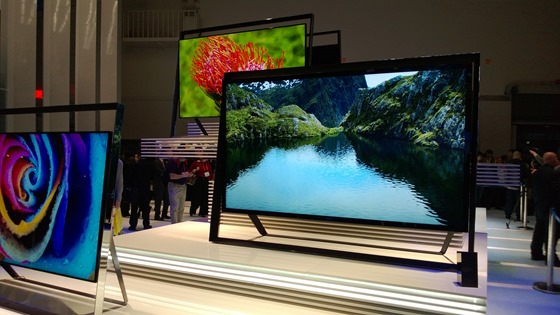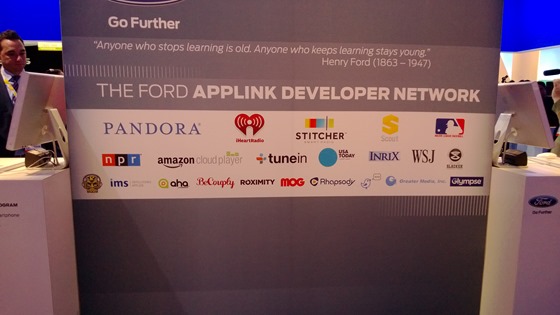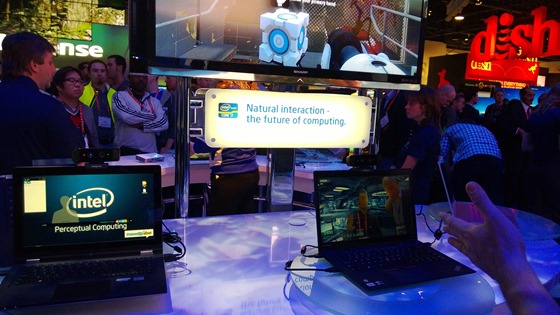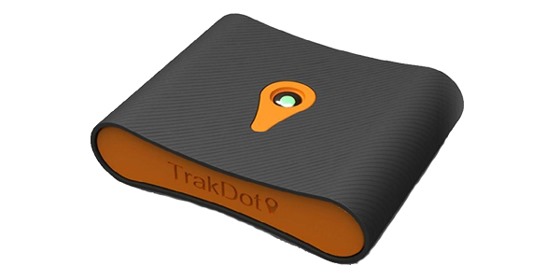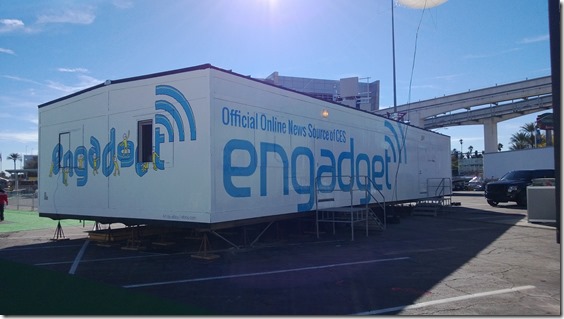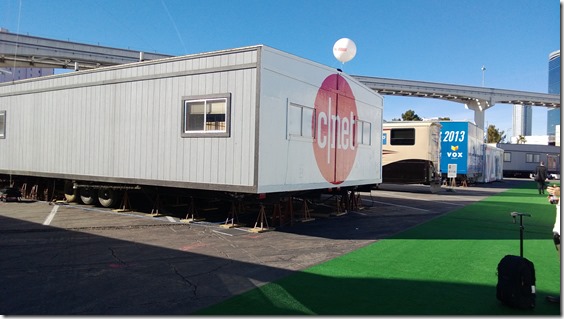I spent around 36 hours at CES last week and probably around 6 of that walking the actual show floor, taking notes on OneNote on Windows Phone (and Surface when stationary). What surprised me is I got to see almost everything I wanted in that short space of time and from reading other reports, I only missed a few things. When asked how this year’s event was, my main piece of feedback has been that there was very little surprising stuff there. Still, it’s a great opportunity to see a lot of things from many companies/competitors in a short space of time. Ultimately, that was my goal. With all that said, here are the key themes/trends I saw.
Display Technology
Even before I arrived I knew I should prepare for the onslaught of even bigger, higher def screens than I saw last year. I wasn’t disappointed. Samsung’s 85” ‘easel’ style Ultra HD set was the most jaw dropping both in terms of size and quality of image. It was breathtaking, but without 4k content I think I’d soon tire of watching life-like lions roaming around my apartment – mind you, it would take up most of my apartment so I’d have to get used to eating, sleeping, working and watching from this unit.
Other notable display technologies I saw included a curved OLED from Samsung – though I tend to agree with David Pogue that the marketplace for curved screens does seem somewhat limited. Nevertheless, impressive stuff and LG has one too. As is customary, screens showed up in fridges, cars and many other places. Samsung’s
flexible screen had me cooing, especially when our own Eric Rudder showed a Windows Phone prototype using the technology.
Aside from the 85” Samsung, the screen that caught my eye the most was Panasonic’s 20” 4k tablet – which basically looked like a very thin screen. In actuality, it was a full-fledged PC running Windows 8 with amazing clarity due to the Ultra HD spec. The demo station showed content such as architectural drawings,, but even the Windows start screen looked stunning at that resolution. Tom Warren has a good hands-on video.
My takeaway from this visual overload? Displays are going to be everywhere and anywhere in the coming years but the innovation needs to come from the content, not the displays themselves. I wrote a post almost exactly a year ago asking where is the“Steve TV” button on my remote and Mat Honan penned something similar recently in WIRED
Auto tech
This year I managed to venture out and visit Audi, Ford, Kia, Hyundai and Chevrolet. The pick of the booths was Audi, which was a visual assault – parts of it being in almost darkness and other parts being in very, very bright white light. Moving from one to another was akin to going from a Vegas nightclub on to the casino floor. Audi had some interesting stuff on show too – not least a 3D screen that didn’t require glasses (and used a Microsoft LifeCam – I assume for head tracking), a traffic jam driver assist feature (the car will drive for you at speeds under 37 mph), a prototype 3D audio system co-developed with Bang & Olufsen (housed in a Q7), and, for the invited few, a glimpse at Audi’s self driving car.
Ford’s booth was also interesting because they had a Nest remote and a washing machine installed. That struck me as odd but when I stopped to explore, it was interesting to see Ford pushing a holistic energy management approach. They also launched the SDK for developers to build apps that run in Ford vehicles, further blurring the lines between industries. Aside from these big name car manufacturers, there were a ton of other companies showing off booming hifi’s and all other kinds of souped-up car paraphernalia. My days of modding my car are long gone though so I spent little time here.
My takeaway from this section – cars are becoming more and more about software engineering as well as vehicle engineering. Frankly, the sooner my car is more intelligent—connected to my phone, my home, the city and the highway—the better as I want the intelligence those connections can bring to my travel, parking and home automation needs. On the other hand, my 2007 Audi is perhaps the last bastion of calm for me right now as it’s relatively low tech inside (no Bluetooth, no Sat Nav), so maybe I shouldn’t wish for anything to invade my thirty minute commute?
NUI
I know I sound like a broken record on Natural User Interfaces – but I saw more and more of them at CES. Panasonic’s “My Home Screen” on its Viera line of TVs allows each family member to create their own home screen, which appears when you appear in front of the TV, thanks to facial recognition. I increasingly saw voice-driven TVs too. LG also had motion sensing TVs that allow control of the screen using just one finger, while their Magic Remote allows you to write numbers in the air to change channels. That seems like an odd interaction mode to me but it’s always interesting to see options.
Intel even had a natural interaction pod in their booth where they were showing a gesture-based interface on a PC using a depth camera.
Speaking of Intel, they had an awesome lineup of PCs – pretty much all of which had touch. That was another big theme of the show for me but not unexpected, so I’m not going to dwell on it here – though it is very much part of the NUI trend. PSFK has some great shots of Intel’s CES Ultrabook ‘tree’ and it didn’t pass me by that
Intel has announced touch as a mandatory feature of the next round of Ultrabook’s featuring their Haswell chip.
Internet of Things
I went expecting (maybe hoping) to see a lot more stuff in this category. There was certainly a lot of home automation tech – from appliance manufacturers such as Panasonic and auto companies.
Aside from that there wasn’t much else, perhaps because everything is connected to the Internet and some of the things that aren’t (street signs) aren’t likely to show up at CES. I was disappointed that the BERG Little Printer wasn’t at the show (mine has gone back to London for a few repairs) and those were the types of devices I was hoping to see more of.
Maybe the Trakdot luggage tracker fits this category – it’s certainly a device I thought was fun and innovative. It tracks your luggage anywhere in the world. When you fly, Trakdot knows and goes to sleep. And when you arrive at your destination it wakes up and reports its new location via a text-message or email. Sad that such a
product needs to exist but when you’re lugging expensive gear, it’s a neat solution. It’s scheduled for release in March.
Another tracking product I like the idea of is StickNFind Bluetooth stickers – ultra small stickers with Bluetooth that you can stick on any device, person or animal. You canthen find them with your Apple iOS or Android device. I like the idea and it seems others do too as the team’s goal of raising $70k on Indiegogo has been met over tenfold already. Commit to a Windows Phone app and you have my $65 😉
Random Stuff
As I expected with CES, there were a few random things that caught my eye that don’t fit in to one of my categories above. Here’s a quick rundown:
- Toshiba’s concept watch
- HAPIfork – a fork that buzzes when you eat too quickly
- Urban Hello – a smartphone for home
- Cases – there were a couple of football fields worth of companies showing off cases (largely for Apple devices) and that ecosystem reminds me of the days of the Nokia snap on covers for phones. It shows no sign of slowing and an ability to cater to every taste – good or bad.
- Seagate’s Wireless Plus – a wireless hard drive with 10hr battery life, 1TB of storage and USB 3.0. I’ve already pre-ordered this puppy.
- Six Parrot AR 2.0 Drones dancing to booming music in the car park
- Media trucks – these boys and gals boss the show coverage and have trucks to show for it. The Verge truck won on the looks front.
Summary
That’s all for my trip report. Probably nothing you haven’t already read from the big boys in their satellite media trucks. In addition to The Verge, c|net and Engadget, I also followed Mashable’s coverage and really enjoyed the approach WIRED took.
Will I be back next year? Maybe…probably. Yeah, go on then.


